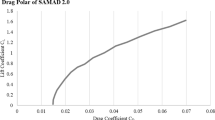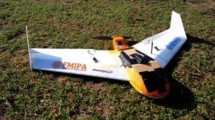Abstract
Dynamic scale model of aircraft is a model established in accordance with the laws of dynamic similitude and used in the research of flutter and other aeroelastic facts [1]. A result obtained under laboratory conditions was transferred to full-scale aircraft with conversion.
You have full access to this open access chapter, Download conference paper PDF
Similar content being viewed by others
Keywords
- Unmanned aerial vehicle
- Dynamic scale model
- Long endurance unmanned aerial vehicle
- Flying laboratory
- Aviation research
- Scaling
The scope of work carries out in the AO NPO OKB M.P. Simonova in order to manufacture a dynamic scale model of long endurance unmanned aerial vehicle (UAV). As part of these activities scaling factors were determined by geometric, aerodynamics, weight, inertial scaling factors and engine-propeller power plant indicators, structural construction of dynamic scale model was designed, designed and manufactured tooling, manufactured, assembled, and tested a dynamic scale model.
In the process of creating a new prototype, we have to carry out extensive research of its aerodynamic performance, stability, controllability at the different flight modes, with different center-of-gravity. Most of these issues can be resolved by examining the model of the aircraft in an air tunnel, but the final testing and debugging is performed on a plane built. Under this system of research, defects can be detected very late, to remove them usually requires debugging and design of the second version of the aircraft. All these make the design of the aircraft much more expensive, delays the launch of a series and it leads to system aging, when all spent money does not give the desired impact. Conducting pre-flight study on dynamic scale flying model brings some benefit. A significant part of the future prototype defects can be detected and eliminated in advance. Due to the high cost of production of UAV dynamic scale model flight research carried out in real flight conditions allows to approach the full-scale tests on the UAV with greater confidence.
Purpose and field of application
-
A flying laboratory for testing control algorithms similar algorithms of full-scale unmanned aerial vehicle;
-
Simulation and testing on dynamic scale model on various emergency power rating UAV kind.
Dynamic similarities in relation to the UAV are as follows:
-
Similarity of geometrical characteristics;
-
Similarity aerodynamic characteristics;
-
Similarity rotor-propeller group;
-
Weighing likeness;
-
Similarity on the inertial characteristics.
The first step in the creation of the dynamic scale model is to determine the design definition. Be aware that small elements create manufacturing complexity and it is necessary to make the structural analysis, to make adjustments. Dynamic scale model has the same weight and stiffness distribution and provides a semblance of aerodynamic effects.
The work on the selection of scaling factors is performed in the developed design definition. All geometrical dimensions should be scaled with the scale factor equal to 1/5.66.
When this model is made of original material it will be stiffer. That means the deformations, stresses, twisting, and bending angels are proportional to scale.
Scaling Coefficients Calculations
In the process of calculation were used formulas. Some formulas are derived from open sources, while others were withdrawn by yourself.
Geometric characteristics
-
The wingspread of UAV—m;
-
Choose wingspread of dynamic scale model—n;
-
Scaling factor: \( {\text{scale}} = \frac{m}{n} \);
-
Length factor: \( f_{\text{length}} = {\text{scale}} \);
-
Thickness coefficients of the compound material: \( f_{\text{compoundthick}} = {\text{scale}} \)
If the thickness of the compound material becomes smaller than the thickness of the used material, a single layer of material is applied in manufacturing.
Aerodynamic characteristics
-
Surface factor of dynamic scale model: \( f_{s} = {\text{scale}}^{2} \)
-
Volume of dynamic scale model: \( f_{v} = {\text{scale}}^{3} \)
-
Wing loading factor: \( f_{\text{pressure}} = \frac{{f_{m} }}{{f_{s} }} = {\text{scale}} \)
-
Flight speed factor: \( f_{\text{speed}} = \sqrt {f_{p} } = \sqrt {\text{scale}} \)
-
Deflection angle: \( f_{{{\text{defl}} . {\text{angl}}}} = \frac{{f_{\text{force}} \;f_{\text{length}}^{2} }}{{f_{I} }} = \frac{{{\text{scale}}^{5} }}{{{\text{scale}}^{5} }} = 1 \)
-
Coefficient Reynolds number: \( f_{{\Re }} = f_{\text{speed}} \cdot f_{\text{length}} = {\text{scale}}^{1.5} \)
After manufacture and assembly carried out center-of-gravity positions dynamic scale model similar centering of full-scale UAVs within a predetermined range of the arithmetic average of the chord.
Characteristics of the rotor-propeller group
-
Engine power: \( P = P_{1} \cdot f_{\text{power}} \)
-
Propeller diameter: \( D = D_{1} \cdot f_{\text{length}} \)
-
Propeller speed: \( {\text{RPM}} = {\text{RPM}}_{1} \cdot f_{\text{RPM}} \)
-
Propeller tip speed: \( \omega = {\text{RPM}}_{1} \cdot f_{\text{RPM}} \cdot \pi \cdot D_{1} \cdot f_{\text{length}} = {\text{RPM}}_{1} \cdot \pi \cdot D \)
-
Ratio speed: \( f_{\text{RPM}} = \frac{{f_{\text{speed}} }}{{f_{\text{length}} }} = \frac{{\sqrt {\text{scale}} }}{\text{scale}} = {\text{scale}}^{ - 0.5} \)
-
The relative pace of the screw: \( f_{\uplambda} = \frac{{f_{\text{speed}} }}{{f_{\text{RPM}} \cdot f_{\text{length}} }} = \frac{{\sqrt {\text{scale}} }}{{{\text{scale}}^{ - 0.5} \cdot {\text{scale}}}} = 1 \)
-
The weight of power plant: \( W_{\text{pp}} = W_{{{\text{pp}}1}} \cdot f_{m} \)
Weighing likeness
-
Weight: \( f_{m} {\text{scale}}^{3} \)
Inertial characteristics
-
The moment of inertia factor \( f_{I} = f_{{{\text{comp}} . {\text{thick}}}} \cdot f_{\text{length}}^{3} = {\text{scale}}^{4} \)
Analysis of the values carried out after the calculations determined the areas of strength and weakness. There are such cases, when the calculated thickness of cover degenerate and model becomes non-complying. In such cases, it is necessary to ignore the laws of scaling and seek solutions to meet the strength requirements.
Design the Plane
Design of the aircraft was carried out with the use of modern computer-aided design (CAD) system and support of the product lifecycle: Siemens NX, ANSYS, Teamcenter. These programs allow you to conveniently work with dynamic scale model, identify inconsistencies in the design and make the necessary changes in order to minimize costs, definition performance, create working construction documentation.
Dependency presented above was tested in the creation dynamic scale model. Their consistency was tested at the characteristic element of the aircraft structure—cowl of nacelle.
The initial data for the production of a cowl of nacelle is the airfoil that is obtained from the Central Hydrodynamic Institute Zhukovsky (TsAGI). Solid model elements are created with the calculated thickness of cover in computer-aided design system by according scaled airfoil (Fig. 1).
Composite materials that have good characteristics by design and technological parameters were selected as the basic structural material of airframe of dynamic scale model, because modern constructions are required to have a high strength with minimal weight and overstability, robustness, durability, stiffness, manufacturing and maintainability, aerodynamic performance.
Different technologies are applied during the production of details of composite materials which are different in complexity, cost, and equipment. The selection of a technology is conditioned to the volume of production, the degree of preparation, economic evaluation of production efficiency.
AO NPO OKB M.P. Simonova is equipped with modern mechanical processing equipment. Methods of the vacuum and autoclave molding of large composite components are controlled and widely used there. It is necessary to have a forming tool for the creating construction elements.
Forming tool is created from the same material as the cowl of nacelle in order to get the same expansion coefficient during heating at the forming process. Forming tool consists of two elements: the top and bottom parts. The basic elements of molding tool of the aerodynamic contour should be designed with considering the production technology. Molding tool of nacelle of cowl made of glass fiber which is more economically efficient and simple. Forming tools of composite material are lighter, they can retain the shape and size, have a high mechanical properties and low contraction. It enables their manufacture with narrow tolerances.
Forming tool has shapes form, so it required doing master-model. Master-model is made on CNC production center from Medium Density Fiberboard (Fig. 2). Tool for molding hood of nacelle was made by the master-model. It is necessary to create the electronic model for the production of the master-model on CNC production center. The electronic model is created in the program Siemens NX. There are many modules for creating processing programs for production center.
On the basis of the enterprise master-models and forming tool for molding structural elements are made (Fig. 3).
All parts, including the lightly stress loaded thin-walled cover and the elements of the load carrying structure are made of composite materials (Fig. 4). In manufacture used modern components such as reinforcing materials from in glass and carbon fiber.
The main aircraft performances are shown in Table 1, the overall dimensions in Fig. 5.
At the moment, dynamic scale model of UAV long duration flight creates on AO NPO OKB M.P. Simonova and undergoing flight tests.
Conclusions
Using dynamic scale model in the development of new aircraft can significantly reduce the time for design of production. This is achieved by carrying out pre-flight test at critical control modes. These post-flight values from dynamic scale model are transferred to the full-scale plane by conversion factors. In addition to the use of such a dynamic model for aviation research, this development provides a great practical advance in the production of small UAVs. This class of unmanned aerial vehicles has proven itself in the field of monitoring the area and infrastructure.
References
Cheranovskii, O.R.: Dreams and reality or the way to science (2010)
Acknowledgements
Researches are carried out (conducted) with financial support of the state represented by the Ministry of Education and Science of the Russian Federation. Agreement (contract) no. 02.G25.31.0122 14.Aug.2014.
Author information
Authors and Affiliations
Corresponding author
Editor information
Editors and Affiliations
Rights and permissions
This chapter is published under an open access license. Please check the 'Copyright Information' section either on this page or in the PDF for details of this license and what re-use is permitted. If your intended use exceeds what is permitted by the license or if you are unable to locate the licence and re-use information, please contact the Rights and Permissions team.
Copyright information
© 2018 The Author(s)
About this paper
Cite this paper
Fedotov, V.S., Gomzin, A.V., Salavatov, I.I. (2018). Design of Dynamic Scale Model of Long Endurance Unmanned Aerial Vehicle. In: Anisimov, K., et al. Proceedings of the Scientific-Practical Conference "Research and Development - 2016". Springer, Cham. https://doi.org/10.1007/978-3-319-62870-7_28
Download citation
DOI: https://doi.org/10.1007/978-3-319-62870-7_28
Published:
Publisher Name: Springer, Cham
Print ISBN: 978-3-319-62869-1
Online ISBN: 978-3-319-62870-7
eBook Packages: Chemistry and Materials ScienceChemistry and Material Science (R0)









